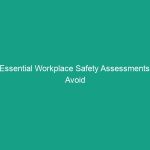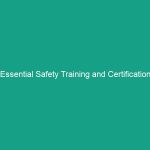Introduction
Good morning team! Today, we’re going to discuss a crucial topic that directly impacts our Safety on the job – Essential Carabiners: Must-Know Safety Tips to Avoid Critical Risks. Carabiners may seem like simple tools, but when used improperly, they can lead to serious accidents. Understanding how to use them safely is vital for our daily operations and overall Workplace Safety.
So, why is this topic important? Carabiners are widely used in various industries, including construction, rock climbing, and rescue operations. Their versatility makes them essential, but it also means that we need to be aware of the risks associated with their use. Let’s dive into the details to ensure we all stay safe!
Understanding Essential Carabiners
Carabiners are metal loops with a spring-loaded gate that allow for quick and secure connections between ropes, harnesses, and other equipment. They come in various shapes, sizes, and materials, each designed for specific applications. Understanding the right type of carabiner and its uses is critical for maintaining safety.
It’s a common misconception that all carabiners are created equal. In reality, the strength, locking mechanism, and intended use of each type vary significantly. Ignoring these differences can lead to fatal mistakes, particularly in high-risk environments.
Key Hazards, Risks, and Safety Considerations
Using carabiners without proper knowledge can expose employees to a range of Hazards. Here are some key risks associated with carabiner usage:
- Incorrect Load Capacity: Each carabiner has a specific weight limit. Overloading can cause the carabiner to fail, leading to falls or accidents.
- Improper Locking Mechanism: Failing to use a locking carabiner correctly or using non-locking types in critical situations can result in unintentional disengagement.
- Wear and Tear: Regular use can lead to degradation of the carabiner material. Inspecting them for signs of wear is essential to prevent failure.
- Environmental Factors: Exposure to extreme temperatures, chemicals, or moisture can compromise the integrity of a carabiner.
Ignoring these risks can lead to serious, sometimes fatal, consequences. For example, a worker might assume a non-locking carabiner is secure, leading to a fall from height. Always prioritize safety and proper equipment use.
Best Practices, Procedures, & Actionable Advice
To minimize risks associated with carabiners, here are some Best Practices to follow:
- Choose the Right Carabiner: Ensure you select a carabiner that meets the requirements of your specific task. For high-load applications, use locking carabiners with a minimum strength rating of 20 kN.
- Inspect Before Use: Always perform a pre-use inspection. Check for cracks, rust, or any signs of damage. If you find any issues, do not use the carabiner.
- Properly Lock Carabiners: If using a locking carabiner, ensure it is locked before putting weight on it. Familiarize yourself with the locking mechanism—whether it’s a screw-lock, twist-lock, or auto-lock.
- Secure Connections: Ensure proper attachment to harnesses, ropes, or other gear. Always double-check connections before starting any work that involves height or risk.
- Store Properly: When not in use, store carabiners in a dry, clean place to prevent deterioration. Avoid leaving them exposed to harsh weather conditions.
Let’s look at a real-world incident. In 2019, a climber fell due to a failure in a non-locking carabiner that was incorrectly secured. This incident underscores the importance of using the right equipment and ensuring that all safety protocols are followed.
Regulations, Standards, and Compliance
Adhering to safety Regulations is not just a best practice; it’s a requirement. In the United States, OSHA provides guidelines for Fall Protection in the workplace. According to osha, all fall protection systems must be designed, installed, and maintained to meet the requirements outlined in the regulations.
Additionally, following Standards set by organizations like ANSI (American National Standards Institute) ensures that the equipment we use, including carabiners, meets safety and performance specifications. Compliance is critical not only for legal reasons but also for protecting your well-being and that of your coworkers.
Employee Engagement & Discussion
Let’s take a moment to discuss. Have you encountered any challenges related to carabiner use in your work? What Precautions do you take to ensure your safety? Sharing your experiences can help us all learn and improve our practices.
Conclusion & Key Takeaways
In summary, understanding the essential aspects of carabiner safety is crucial in preventing accidents and ensuring a safe working Environment. Remember to:
- Use the right carabiner for the job.
- Inspect equipment before use.
- Lock carabiners properly.
- Store them safely when not in use.
- Follow OSHA and ANSI guidelines for compliance.
Your safety and the safety of your coworkers depend on your adherence to these practices. Thank you for your attention today, and let’s continue to prioritize safety in everything we do!


